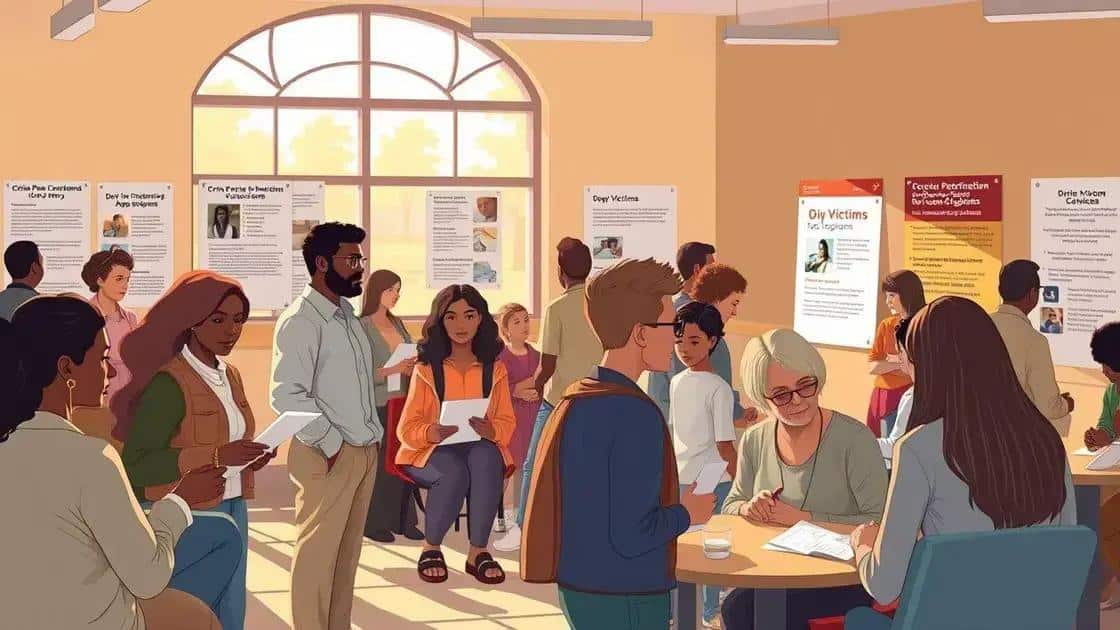Crime public assistance access: Understanding the challenges

Advocacy in crime assistance programs is crucial for supporting victims by providing information, legal support, and influencing policy changes to enhance accessibility and effectiveness of available resources.
Crime public assistance access is a crucial topic that often goes unnoticed. Many individuals find themselves navigating complex systems when seeking help, raising the question: how can we make this process easier and more effective?
Understanding the relationship between crime and public services
Understanding how crime interacts with public services is essential for improving community safety and access to resources. Many people are affected by crime, which can ripple through public services such as law enforcement, healthcare, and social assistance.
Impact on Law Enforcement
Crime directly affects how law enforcement operates. Police departments often need to allocate more resources to areas with high crime rates. This can lead to a lower quality of service in neighborhoods that are less frequented by criminal activities. Community policing is an approach aimed at building relationships between police and the community to enhance trust and safety.
Healthcare Response
Another crucial connection is how crime influences access to healthcare services. Victims of crime often require medical assistance, yet many may hesitate to seek help due to fear of police involvement. This can lead to untreated injuries and psychological trauma.
- Overlapping roles of emergency services and social workers.
- Increased demand for mental health services.
- Collaboration to provide immediate care for victims.
Furthermore, preventing crime through social programs can reduce the strain on healthcare systems. Programs that support at-risk youth, for instance, can not only deter criminal behavior but also promote healthier communities.
Social Assistance Programs
Public assistance programs can also be influenced by crime rates. Communities with higher crime often suffer economically, reducing the ability of families to access essential support. This creates a cycle where crime leads to economic hardship, further resulting in increased criminal activity. Efforts to strengthen these programs are necessary. Expanding access to public assistance can provide stability to families, thereby decreasing crime rates.
- Tailoring services to meet resident needs.
- Increasing funding for local programs.
- Implementing educational workshops to raise awareness.
By understanding the dynamic interplay between crime and public services, communities can devise strategies to improve access and outcomes. Collaborative approaches involving law enforcement, healthcare, and social services pave the way for a more integrated response to crime, ultimately fostering a safer environment for all.
Barriers to accessing crime assistance programs
Accessing crime assistance programs is often hindered by several barriers that many individuals face. These barriers can make it difficult for victims to receive the support they need during challenging times. Understanding these obstacles is crucial for improving the overall outreach and effectiveness of assistance programs.
Language and Communication Issues
One significant barrier is language. Many victims may not speak English fluently, making it hard for them to communicate their needs effectively. This miscommunication can lead to frustration and a lack of access to vital resources. Moreover, if assistance programs do not have staff proficient in multiple languages, non-English speakers may feel isolated.
- Use of interpreters to aid communication.
- Availability of materials in multiple languages.
- Training staff on cultural sensitivity.
Equipping programs with these resources can drastically improve accessibility for diverse populations.
Stigma and Fear
Another major barrier is the stigma associated with being a victim of crime. Many people worry about being judged or not believed when they seek help. This stigma can prevent them from reaching out to assistance programs. Additionally, fear of retribution from their attackers can make victims hesitant to come forward and share their experiences.
Public awareness campaigns can help combat the stigma surrounding crime victims. Providing a safe and supportive environment can encourage more individuals to seek help when they need it most. This change not only helps victims but also enhances community trust in public assistance programs.
Limited Knowledge of Available Resources
Often, individuals do not know what resources are available to them. Many victims may assume there are no programs that can help or may have difficulty finding relevant information. This lack of knowledge can be detrimental, preventing victims from accessing crucial support systems.
- Creating outreach programs to educate communities.
- Utilizing social media to share information.
- Establishing partnerships with local organizations.
By actively promoting available services, assistance programs can raise awareness and improve accessibility for those in need. Addressing these barriers effectively will not only provide a better response to victims of crime but can also foster a more supportive community.
Impact of crime on community support systems

The impact of crime on community support systems cannot be underestimated. When crime rates rise, the entire fabric of the community can feel the strain. Community support systems, such as local organizations, schools, and healthcare facilities, often bear the brunt of increased demand while facing the challenge of limited resources.
Strain on Local Organizations
As crime increases, local organizations dedicated to supporting victims may experience a surge in their workload. These organizations often provide essential services such as counseling, legal assistance, and emergency resources.
- Heightened demand for counseling and mental health services.
- Increased need for legal aid and advocacy.
- Pressure on food banks and shelters.
When organizations are overwhelmed, their ability to help each individual effectively diminishes, leaving many without the necessary support.
Effects on Schools
Schools are also significantly affected by crime. Students who experience crime in their neighborhoods or homes may face challenges in their educational environment. They might struggle with concentration and performance due to stress and trauma.
Safety concerns can lead to increased security measures, which often create an atmosphere of fear rather than support. Schools need to implement programs that address the emotional and social needs of students, helping them cope with the impacts of crime.
Healthcare Systems
Healthcare systems often see an influx of patients affected by crime. Emergency rooms may become crowded with victims of violence, which can strain resources and push waiting times longer for everyone needing care.
- Need for dedicated trauma care services.
- Increased partnerships with mental health services.
- Community wellness programs to foster healing.
This heightened demand redirects focus and resources away from regular healthcare needs, impacting overall community health.
Addressing the impact of crime on community support systems requires a collaborative approach. By ensuring these systems are supported with adequate funding and resources, communities can build resilience and help individuals recover from the effects of crime.
Strategies for improving access to assistance
Improving access to assistance programs is vital for supporting victims of crime and aiding community recovery. Several strategies can be implemented to enhance these services, making them more accessible and effective for those in need.
Community Outreach Initiatives
One important strategy is to engage in community outreach initiatives. These programs can raise awareness about available resources, helping individuals understand what support they can access. Utilizing local events, workshops, and social media can convey vital information.
- Host informational sessions in local community centers.
- Distribute flyers and brochures in multiple languages.
- Create engaging social media content.
By communicating effectively with the community, organizations can ensure that more people are informed about the assistance available to them.
Partnerships with Local Agencies
Building partnerships with local agencies can also significantly improve access to assistance. Collaboration between different organizations can create a more comprehensive support system.
For instance, when healthcare providers, law enforcement, and social services work together, they can provide seamless support for victims. This integrated approach can streamline the process for individuals seeking help.
- Share resources and referrals between agencies.
- Conduct joint training sessions for staff.
- Establish a coordinated response team for emergencies.
By working together, agencies can expand their reach and enhance the effectiveness of their assistance programs.
Use of Technology
Leveraging technology is another strategy to improve access to assistance. With the rise of digital services, more people can obtain help from the comfort of their homes. Offering online applications and consultations can make these programs more accessible.
Additionally, mobile apps can be created to provide resources and guidance on finding assistance. These tools can help users navigate available options while also maintaining their privacy and safety.
- Develop user-friendly websites.
- Provide virtual counseling services.
- Implement chat features for instant assistance.
By embracing technology, assistance programs can meet the needs of a broader audience and offer support promptly to those affected by crime.
The role of advocacy in crime assistance programs
The role of advocacy in crime assistance programs is essential for ensuring that victims receive the help they need. Advocates work tirelessly to represent and support those affected by crime, ensuring their voices are heard and their rights protected.
Providing Information and Resources
One of the main functions of advocacy is to provide information about available resources. Many victims may not be aware of the assistance programs in their community. Advocates help bridge this knowledge gap by sharing essential details about services such as legal aid, counseling, and emergency housing.
- Creating resource guides for victims.
- Conducting workshops to educate the community.
- Offering one-on-one consultations to explain options.
Through these efforts, advocacy fosters greater awareness and knowledge, empowering victims to seek help.
Supporting Victims During Legal Processes
Advocates also play a critical role in supporting victims through legal processes. Navigating the legal system can be daunting, especially for those already facing trauma from crime. Advocates provide emotional support and practical assistance, helping victims understand their rights and options.
This can include accompanying victims to court, explaining legal jargon, and ensuring they have access to necessary documentation. The presence of an advocate can make a significant difference in a victim’s experience, leading to better outcomes.
Influencing Policy and System Changes
In addition to individual support, advocates work on a larger scale to influence policies and systems. They identify gaps in services and push for changes that benefit the community. This can involve lobbying for better funding, improved training for law enforcement, or the creation of new programs.
- Collaborating with policymakers to address community needs.
- Gathering data to highlight the impact of crime.
- Raising awareness about key issues affecting victims.
Through their efforts, advocates help create a more responsive and effective system for crime assistance, ultimately supporting victims and their families.
FAQ – Frequently Asked Questions about Advocacy in Crime Assistance Programs
What is the role of advocacy in crime assistance programs?
Advocacy provides essential support to victims, ensuring their voices are heard and helping them access the resources they need.
How do advocates help victims during legal processes?
Advocates assist by providing emotional support, explaining legal rights, and accompanying victims to court to ease their experience.
Why is community outreach important in advocacy?
Community outreach raises awareness about available resources, helping victims understand the assistance programs that can support them.
What changes do advocates push for in policies related to crime assistance?
Advocates work to identify gaps in services and lobby for improved funding and resources to enhance the support available for victims.





